-
Research Article
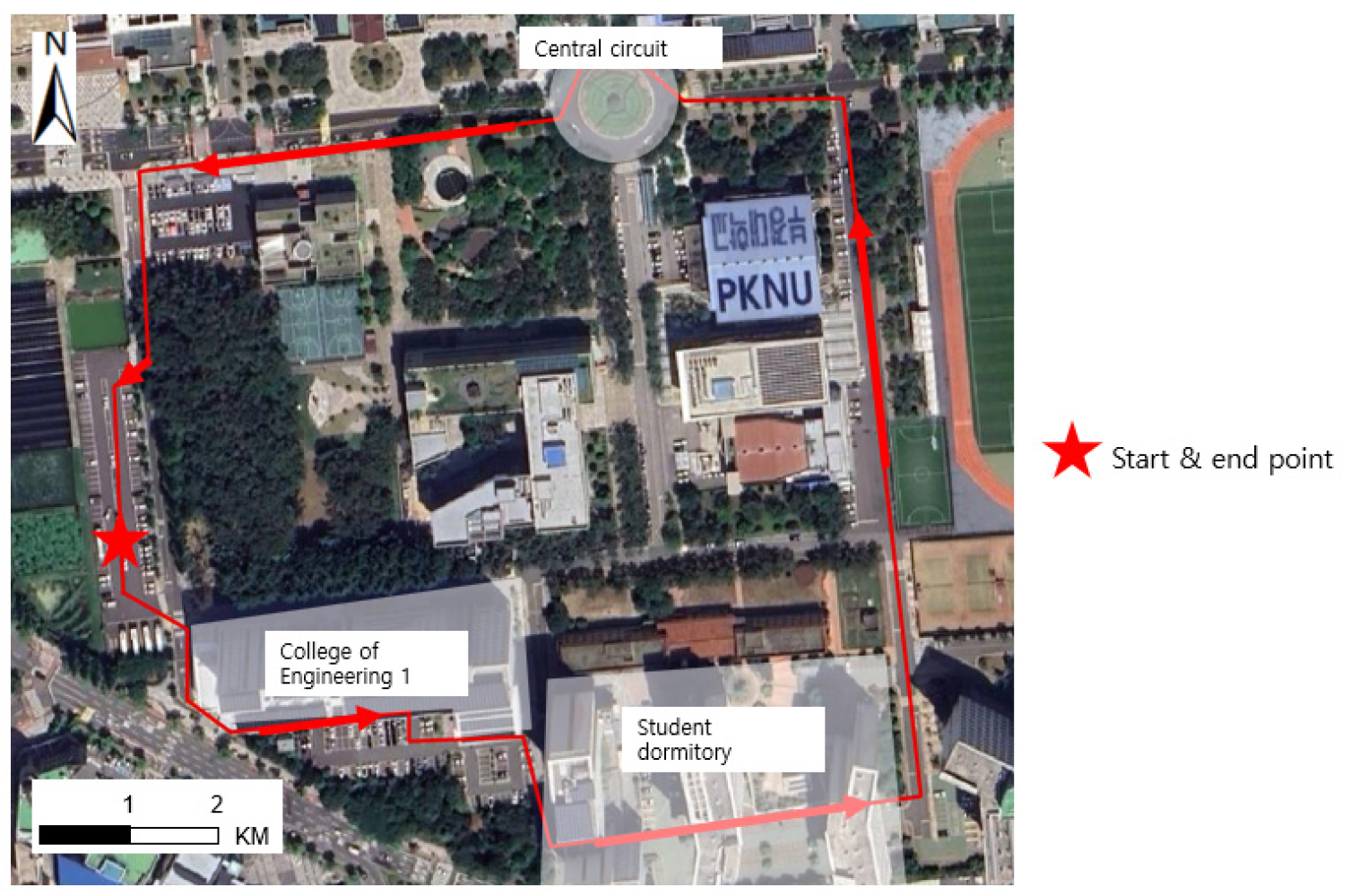
-
Prediction and Validation of Solar Electric Vehicle Energy Generation Considering Solar Module Tilt Angle and Driving Condition
태양광 모듈 경사각 및 주행 조건을 고려한 태양광 전기차의 에너지 발전량 예측 및 검증
-
Kim Minji, Baek Jieun
김민지, 백지은
- In this study, we predicted the energy generation of a solar electric vehicle during driving by considering the tilt angle of the …
- In this study, we predicted the energy generation of a solar electric vehicle during driving by considering the tilt angle of the solar modules and various driving conditions. The experiment was conducted in the Pukyong National University area, where an experimental route was established to allow driving along all four cardinal directions. For the experiment, solar modules, along with a device for adjusting their tilt angle, a pyranometer, and a 360-degree camera were installed on the roof of the vehicle. Hemispherical images were captured at 35 locations along the experimental route, and the annual direct and diffuse irradiance reduction ratios were calculated. The energy generation was predicted by varying the tilt angle of the solar modules from 0° to 45° in 15° increments at 09:00, 12:00, and 15:00 local time, and the prediction accuracy was verified through a driving experiment conducted in November. At 09:00 and 15:00, the highest irradiance was measured when driving westward and eastward, respectively, opposite to the sun’s direction, and the measured irradiance increased as the tilt angle of the solar modules increased. At 12:00, the highest irradiance was observed when driving northward, and similarly, the measured irradiance increased with larger tilt angles of the solar modules. A comparison between the predicted and measured energy generation at the 35 experimental locations confirmed that the variation patterns in prediction and measurement were consistent under different solar module tilt angles and driving conditions. - COLLAPSE
-
Prediction and Validation of Solar Electric Vehicle Energy Generation Considering Solar Module Tilt Angle and Driving Condition
-
Research Article
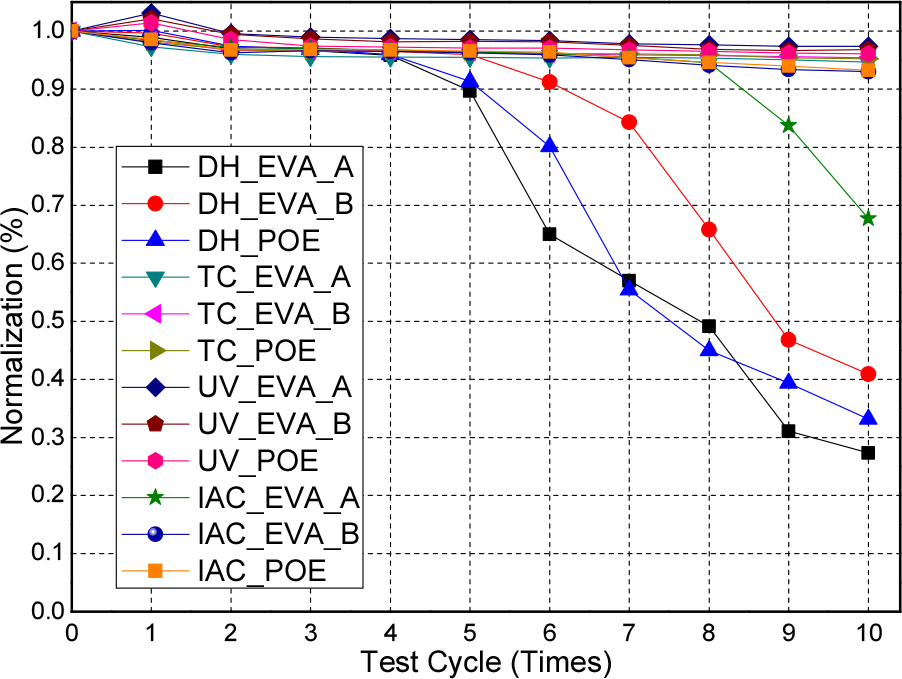
-
Relationship between Acceleration Factor and Equivalent Lifetime of Solar Modules in Long-Term Reliability Testing
장기신뢰성 시험을 통한 태양광 모듈의 가속계수 및 환산수명의 관계
-
Cho YoungHo, Nam WooJun, Cho YongHyun, Kim CyuGwang, Shin YeonBae, Lim Donggun
조영호, 남우준, 조용현, 김규광, 신연배, 임동건
- Photovoltaic modules are tested and certified based on IEC standards, which have been revised continuously since the 1970s. As new information is …
- Photovoltaic modules are tested and certified based on IEC standards, which have been revised continuously since the 1970s. As new information is added to the existing procedures, each test method and sequence builds on the previous test, and as the industry evolved, the IEC test standards became the only standards recognized by both module manufacturers and buyers. However, experts recognize that the IEC test conditions do not match field conditions and that they are too different from field conditions for single tests to be conducted without considering various stressors in combination. In addition, given the circumstances of physical time and economics, it is not feasible to wait 20 or 25 years each time to determine what happens after the module is deployed in the field. In this study, the acceleration factor and equivalent life were calculated by applying an accelerated composite test, rather than a single test, as in the IEC standards, simulating actual field conditions. As a result, we propose a test model that can reduce the test time and save about 40% in terms of equivalent life. - COLLAPSE
-
Relationship between Acceleration Factor and Equivalent Lifetime of Solar Modules in Long-Term Reliability Testing
-
Research Article

-
Performance Evaluation of PV System Built with Used PV Modules
재사용 태양광 모듈을 활용한 태양광 발전소 성능평가
-
Oh Wonwook, Choi Jinho, Heo Jaehyeok, Woo Sungmin, Hong Gibaek, Ryu Seunghwan, Song Hyukgeun, Yang Sumi
오원욱, 최진호, 허재혁, 우성민, 홍기백, 류승환, 송혁근, 양수미
- Photovoltaic (PV) modules have been in operation in the field for more than 20 years, and policies and technologies for the recycling …
- Photovoltaic (PV) modules have been in operation in the field for more than 20 years, and policies and technologies for the recycling of PV modules for resource reuse have been developed and implemented. Even PV modules that have been in operation for more than 20 years retain more than 80% of their initial performance. If there are no failures that affect output mismatch, such as hot spots or cell cracks, they can be reused. In this study, a 50 kWp reused PV system was built using PV modules collected from PV systems that had been in operation for more than 10 years, and the performance of the PV system after operation for 1 year was analyzed. In addition, the PV system was built with the same capacity as new PV modules to compare it with the new modules, and a comparative analysis was performed. IR, EL, and monitoring data analysis were also performed. If the performance of the PV system using reused PV modules can be secured, growth is expected not only in the repowering field but also in the construction of new power plants using reused PV modules. - COLLAPSE
-
Performance Evaluation of PV System Built with Used PV Modules
-
Research Article
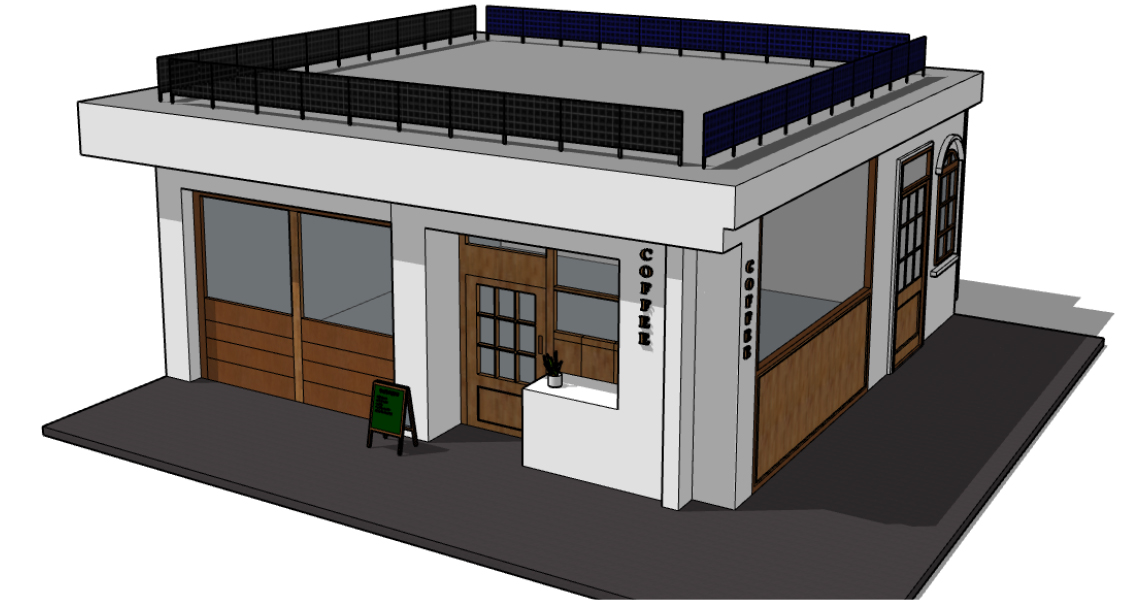
-
Comparative Analysis of the Power Generation Performance of Vertical Bifacial PV Systems Based on Orientation and Albedo
방위 및 알베도에 의한 수직 양면형 PV 시스템의 발전성능 비교·분석
-
Kim Jiwon, Jeong Subin, Kim Jinhee, Kim Juntae
김지원, 정수빈, 김진희, 김준태
- Photovoltaic (PV) systems are typically installed with a tilt angle equal to the latitude of the installation site and oriented toward the …
- Photovoltaic (PV) systems are typically installed with a tilt angle equal to the latitude of the installation site and oriented toward the south to maximize electrical power generation. However, as the proportion of PV systems installed in the south-facing orientation increases, power generation becomes concentrated in short periods, leading to unstable power system operation. To address this issue, interest in east-west-oriented PV systems has grown, as they distribute peak generation times more evenly than south-facing systems. However, east-west PV systems generate less annual power than south-facing systems with the same capacity. Bifacial PV modules have been used to compensate for this drawback. Bifacial PV systems are influenced by installation conditions, such as ground reflectance (albedo) and azimuth, which should be considered during system design. In this study, the variation in power generation owing to changes in azimuth and albedo was quantitatively analyzed through PVsyst simulations for a vertical bifacial PV system. The simulation results indicated that under the lowest albedo condition of 0.2, the annual cumulative power generation of the east-west PV system was approximately 2.27% lower than that of the north-south PV system. However, peak power generation was effectively distributed between 10:00 AM and 2:00 PM. Additionally, when the albedo increased from 0.2 to 0.8, the annual cumulative power generation of the east-west and west-east PV systems increased by up to 78%, surpassing that of the north-south PV system by approximately 0.3%. - COLLAPSE
-
Comparative Analysis of the Power Generation Performance of Vertical Bifacial PV Systems Based on Orientation and Albedo
-
Research Article
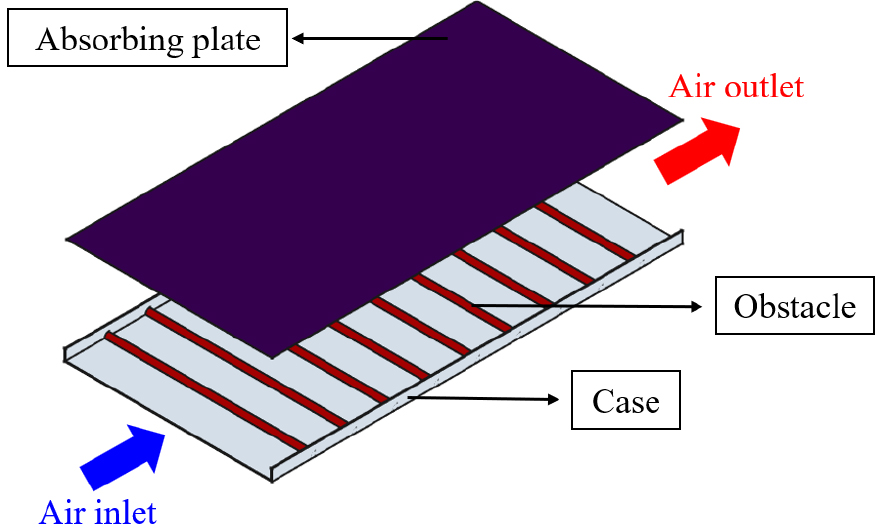
-
CFD Analysis on the Heat Transfer and Pressure Drop Characteristics with Different Installation Location and Shapes of Obstacle in a Solar Air Heater
태양열 공기식 집열기 내 저항체 설치 위치 및 형상에 따른 열전달 및 압력강하 특성에 대한 CFD 해석
-
An Geonyong, Moon Kwangam, An Byeonghwa, Choi Hwiung
안건용, 문광암, 안병화, 최휘웅
- A solar air heater is a system that converts solar energy into useful thermal energy. However, numerous studies have been conducted to …
- A solar air heater is a system that converts solar energy into useful thermal energy. However, numerous studies have been conducted to improve its thermal efficiency because of air’s low thermal conductivity. In this study, the thermal performance of a solar air heater was investigated with a computational fluid dynamics analysis; nine configurations varied the installation positions and shapes of obstacles. As a result, the heat transfer performance improved by 1.044 to 1.707 times compared to that of the solar air heater without obstacles. However, the friction factor increased by 1.52 to 9.26 times due to the presence of obstacles. The performance factor was evaluated to account for both the heat transfer enhancement and pressure drop. The highest performance factor was achieved when the quarter-circle-shaped obstacles—with the arc facing the air outlet side—were installed only on the top surface. Additionally, the greatest heat transfer enhancement was observed when obstacles were installed on both the top and bottom surfaces, which also provided a higher performance factor compared with a solar air heater with obstacles only on the bottom surface. Therefore, installing obstacles only on the top surface is preferable for optimizing the performance factor, whereas installing obstacles on both the top and bottom surfaces is more effective for maximizing heat transfer enhancement. - COLLAPSE
-
CFD Analysis on the Heat Transfer and Pressure Drop Characteristics with Different Installation Location and Shapes of Obstacle in a Solar Air Heater
-
Research Article
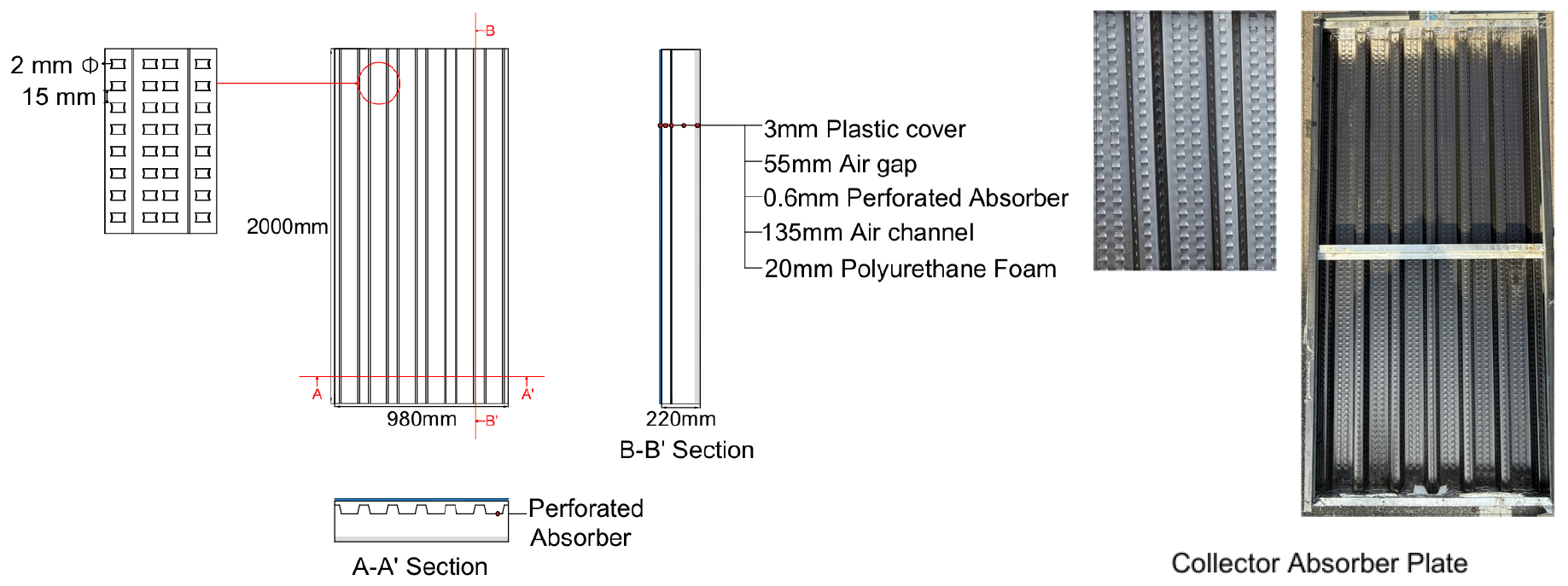
-
Analysis of Thermal Efficiency for Glazed Perforated Solar Collector according to Air-Inflow Method
유창형 타공 태양열 집열기의 공기 유입 방식에 따른 열효율 분석
-
Ki Hyeran, Kim Hayeong, Kim Jinhee, Kim Juntae
기혜란, 김하영, 김진희, 김준태
- The government plans to apply a mandatory zero-energy building (ZEB) certification policy to public and private buildings beginning in 2025. Air-based solar …
- The government plans to apply a mandatory zero-energy building (ZEB) certification policy to public and private buildings beginning in 2025. Air-based solar collectors use air as the heat transfer medium and are classified into glazed and unglazed types. The glazed air-based solar collector has a higher thermal efficiency and reduced sensitivity to external environmental conditions compared with the unglazed type. A glazed air-based solar collector consisting of a glass panel, an absorber plate, insulation, and airflow design influenced by the inlet and absorber plate shape plays a key role in thermal performance. In particular, uniform airflow inside the collector ensures efficient heat transfer and enhances thermal efficiency. Therefore, achieving uniform airflow distribution is essential for improving the thermal performance of air-based solar collectors. In this study, the thermal efficiency of a glazed perforated solar collector was analyzed using different air inflow methods. Outdoor experiments were conducted according to ISO 9806 using closed-loop and open-to-ambient test circuits. Three air inflow methods were tested to evaluate their impact on thermal efficiency. The results showed that at a maximum airflow rate of 150 m3/h, the collector’s efficiency reached 61.01%, which was 35.16% higher than the base case. - COLLAPSE
-
Analysis of Thermal Efficiency for Glazed Perforated Solar Collector according to Air-Inflow Method
-
Research Article
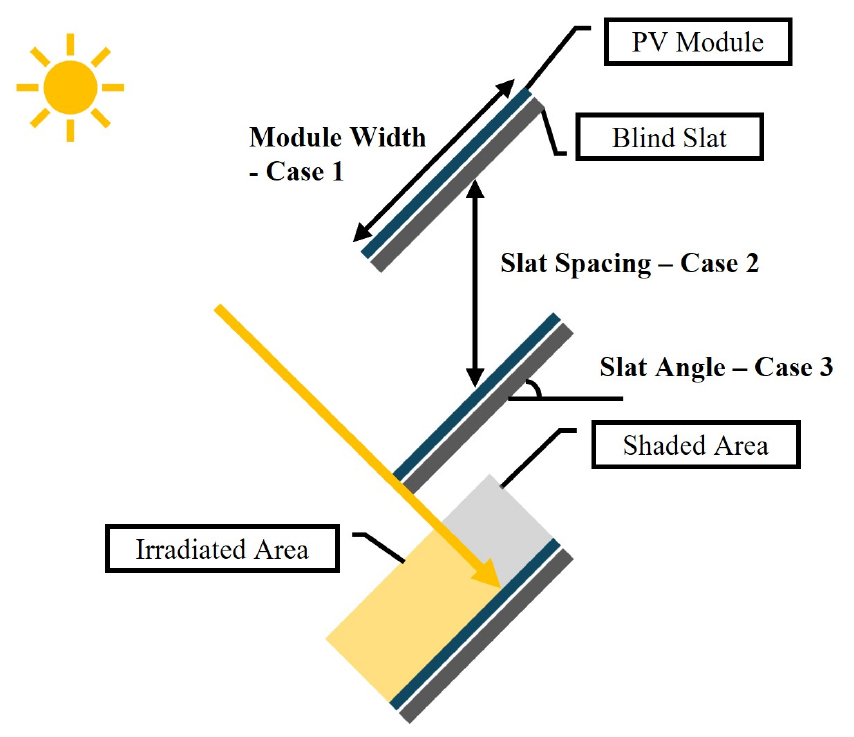
-
Analysis of Power Generation and Indoor Illuminance of Photovoltaic Blinds
태양광 블라인드의 발전량 및 실내 조도 분석
-
Hong Chai-Min, Heo Jae-Baek, Park Sang-Hoon
홍채민, 허재백, 박상훈
- Zero-energy building (ZEB) certification is being increasingly adopted in response to climate change. However, achieving zero energy remains a significant challenge in …
- Zero-energy building (ZEB) certification is being increasingly adopted in response to climate change. However, achieving zero energy remains a significant challenge in apartment buildings, which typically have high energy demands. Conventional rooftop photovoltaic (PV) systems often face spatial constraints, highlighting the need for alternative solutions. Among the emerging PV technologies, PV blinds offer dual functionality: solar power generation and shading. However, prioritizing energy generation can compromise indoor lighting quality. This study investigated the impact of various PV blind parameters on both power output and indoor illuminance. The results show that, although increasing the installation area enhances total energy production, the power output per unit area tends to decrease owing to self-shading effects. Additionally, slat angles closer to perpendicular to the incident solar radiation improve both power generation and indoor illuminance, while contributing to a more uniform light distribution. These findings suggest that PV blinds have a strong potential for advancing the adoption of renewable energy in apartment buildings. - COLLAPSE
-
Analysis of Power Generation and Indoor Illuminance of Photovoltaic Blinds
-
Research Article
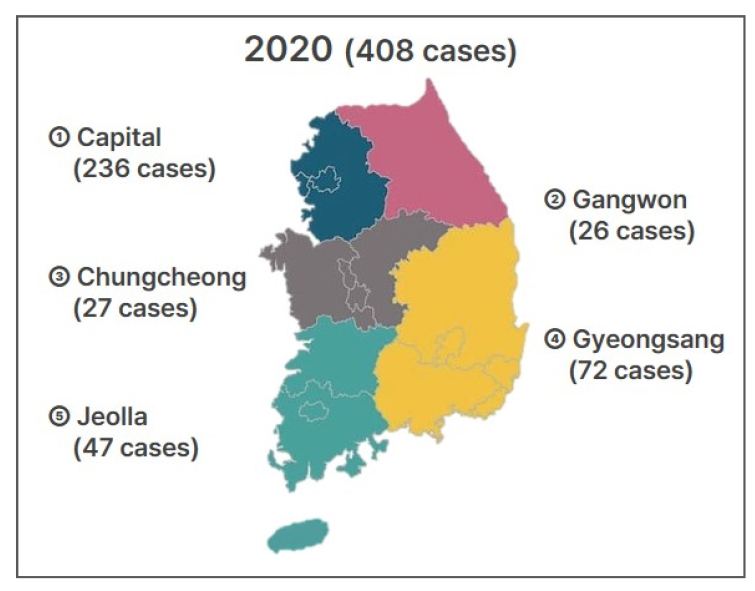
-
Dataset Construction and Analysis for Evaluating Green Remodeling Effects in Public Daycare Centers Based on Actual Energy Consumption
실제 에너지 사용량 기반 공공 어린이집의 그린리모델링 효과 분석을 위한 데이터셋 구축 및 분석
-
Kim Naekyung, Kim Jiwon, Cho Suhyun, Hong Jangho, Kwak Younghoon, Mun Sunhye
김내경, 김지원, 조수현, 홍장호, 곽영훈, 문선혜
- Energy efficiency improvement in the building sector has gained considerable attention as a policy to achieve carbon neutrality. Green Remodeling (GR) projects …
- Energy efficiency improvement in the building sector has gained considerable attention as a policy to achieve carbon neutrality. Green Remodeling (GR) projects targeting public buildings are actively being undertaken to enhance building energy performance. However, most GR impact assessments rely heavily on simulation-based approaches, with empirical analyses using energy consumption data remaining limited. This study investigated GR projects at public daycare centers completed in 2020. A dataset was compiled by integrating pre- and post-GR energy consumption data and their associated technological measures. Core GR interventions, including insulation reinforcement, window replacement, and heating and cooling system upgrades, were identified from energy performance reports. Energy consumption data from 2019 and 2022 were analyzed to measure the effectivity of GR by comparing pre- and post-retrofit energy consumption data. Additionally, a change-point model was applied to the dataset, incorporating weather data to estimate heating and cooling sensitivities (slopes) and base loads (intercepts). The dataset structure was organized according to energy impact categories outlined in IEA EBC Annex 53: Climatic conditions, building envelope, energy systems, occupant profiles, operational patterns, and indoor air quality. By integrating energy consumption data with the technical details of GR measures, this study presents a robust empirical dataset. This dataset can provide support for future research on individual GR intervention effectiveness and increasing evaluation model accuracy. - COLLAPSE
-
Dataset Construction and Analysis for Evaluating Green Remodeling Effects in Public Daycare Centers Based on Actual Energy Consumption
-
Research Article
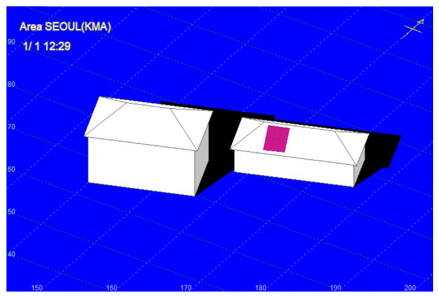
-
A Study on Economic Analysis and Compensation Methods for Photovoltaic Performance Degradation in Changing Urban Environments
도시 환경 변화에 따른 태양광 발전 성능 저하의 경제적 영향 분석 및 손해배상액 산정방안 연구
-
Eum Ji-Young, Choi Gyeong-Seok, Cho Soo-Hwan
엄지영, 최경석, 조수환
- As high-density and high-rise urban building construction proceeds, concerns have developed regarding the performance degradation of photovoltaic (PV) systems installed in existing …
- As high-density and high-rise urban building construction proceeds, concerns have developed regarding the performance degradation of photovoltaic (PV) systems installed in existing buildings resulting from shading from newly constructed or expanded structures. To facilitate the continued expansion of PV systems, it is necessary to establish institutional frameworks for protection of the rights of PV system owners and for structured compensation systems. This study quantitatively analyzes the economic impact of PV performance degradation on rooftop PV systems and proposes a comprehensive compensation scheme. Three cases—typical, disputed, and extreme—were simulated using SolarPro software with Seoul meteorological data. Economic assessments covered three contract types: net metering, power purchase agreements, and market trading. The results show that shading leads to annual power losses of 1.7, 9.0, and 15.3% in the respective cases. Economic analyses revealed significant financial impacts, including higher electricity charges and revenue losses, with conversion of revenues into additional electricity charges in some cases. The proposed compensation scheme incorporates both short-term power losses and long-term effects, including module degradation, inverter efficiency reduction, cascading cumulative shading effects, and economic factors such as inflation and electricity charge increases. This compensation scheme systematically quantifies damages while incorporating the unique characteristics of urban PV systems and their contractual types. The proposed framework provides objective criteria for resolving PV-related conflicts while balancing responsibilities between parties, thereby contributing to urban solar policy development. - COLLAPSE
-
A Study on Economic Analysis and Compensation Methods for Photovoltaic Performance Degradation in Changing Urban Environments
-
Research Article
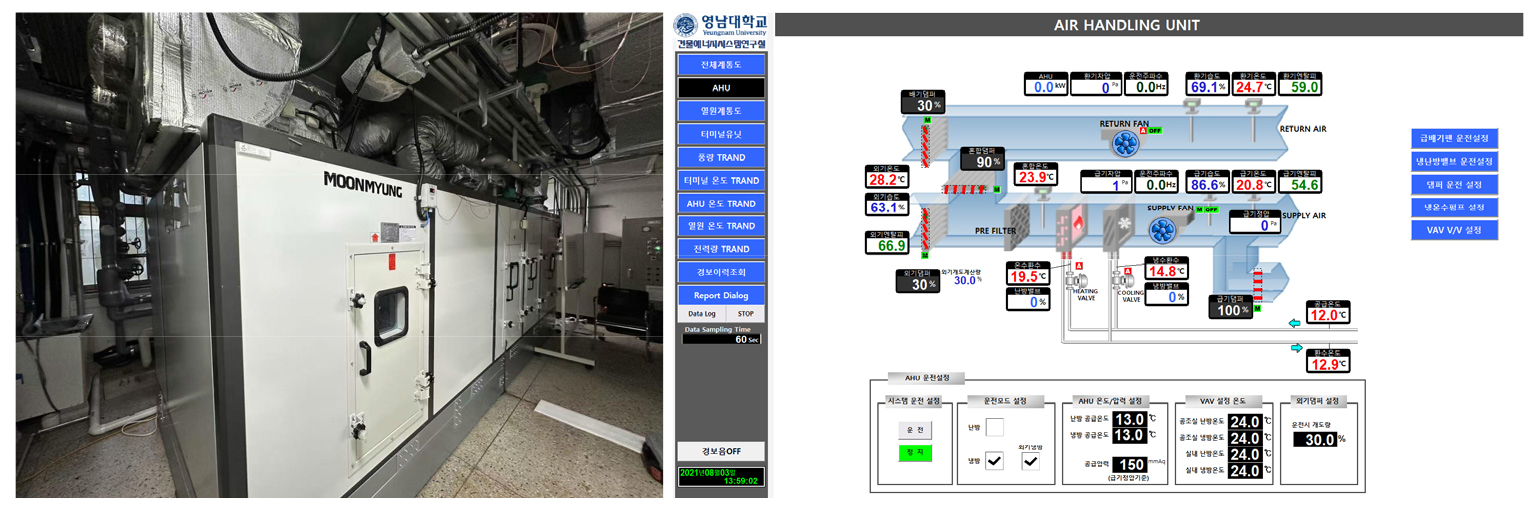
-
Field Application Test of Airflow Monitoring Technology in HVAC Systems
HVAC 시스템 풍량 모니터링 기술의 현장 적용성 검토
-
Wang Yi, Kim Taeyang, Lee JinHyun, Cho Younghum
왕이, 김태양, 이진현, 조영흠
- Air-conditioning systems account for a significant proportion of building energy consumption, and their control strategies have a crucial impact on both energy …
- Air-conditioning systems account for a significant proportion of building energy consumption, and their control strategies have a crucial impact on both energy efficiency and operational accuracy. Variable air volume (VAV) systems capable of dynamically adjusting airflow and temperature are widely used in large buildings. Compared to constant air volume systems, VAV systems offer superior energy efficiency and should therefore be prioritized. Accurate airflow monitoring is a key prerequisite for effective energy saving. To address the challenges in VAV system airflow monitoring, this study proposes an airflow-monitoring method based on field data. This method leverages fan laws and a quadratic fan-performance-curve model incorporating fan speed, duct damper position, and pressure difference to estimate airflow. Experiments were conducted by varying the fan speed (60 Hz) and damper opening (100-20%), and collecting airflow and pressure data. Model performance was validated using multipoint velocity measurements and error data (RMSE, CvRMSE, nRMSE, MBE, and R2). The results established an optimal accuracy at 40 Hz (RMSE = 300.77 CMH, R2 = 0.988, CvRMSE = 9.18%), and reduced precision under extreme conditions (CvRMSE = 28.22% at 20 Hz). This approach offers a low-cost alternative to physical sensors and contributes to improved energy efficiency and intelligent control in VAV-based Heating, Ventilation, and Air conditioning systems. - COLLAPSE
-
Field Application Test of Airflow Monitoring Technology in HVAC Systems
-
Corrigendum
-
CORRIGENDUM to: Analysis of Glare Measurement Methods for BIPV Modules
BIPV 모듈의 눈부심 평가 방법에 관한 연구
-
Kim Hayeong, Kim Jinhee, Kim Juntae
김하영, 김진희, 김준태
-
CORRIGENDUM to: Analysis of Glare Measurement Methods for BIPV Modules
Journal Informaiton
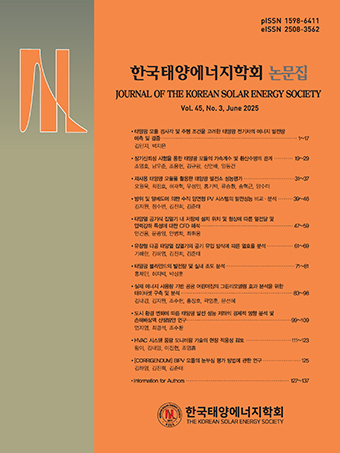 Journal of the Korean Solar Energy Society
Journal of the Korean Solar Energy Society
Journal Informaiton
Journal Informaiton - close
 Journal of the Korean Solar Energy Society
Journal of the Korean Solar Energy Society











